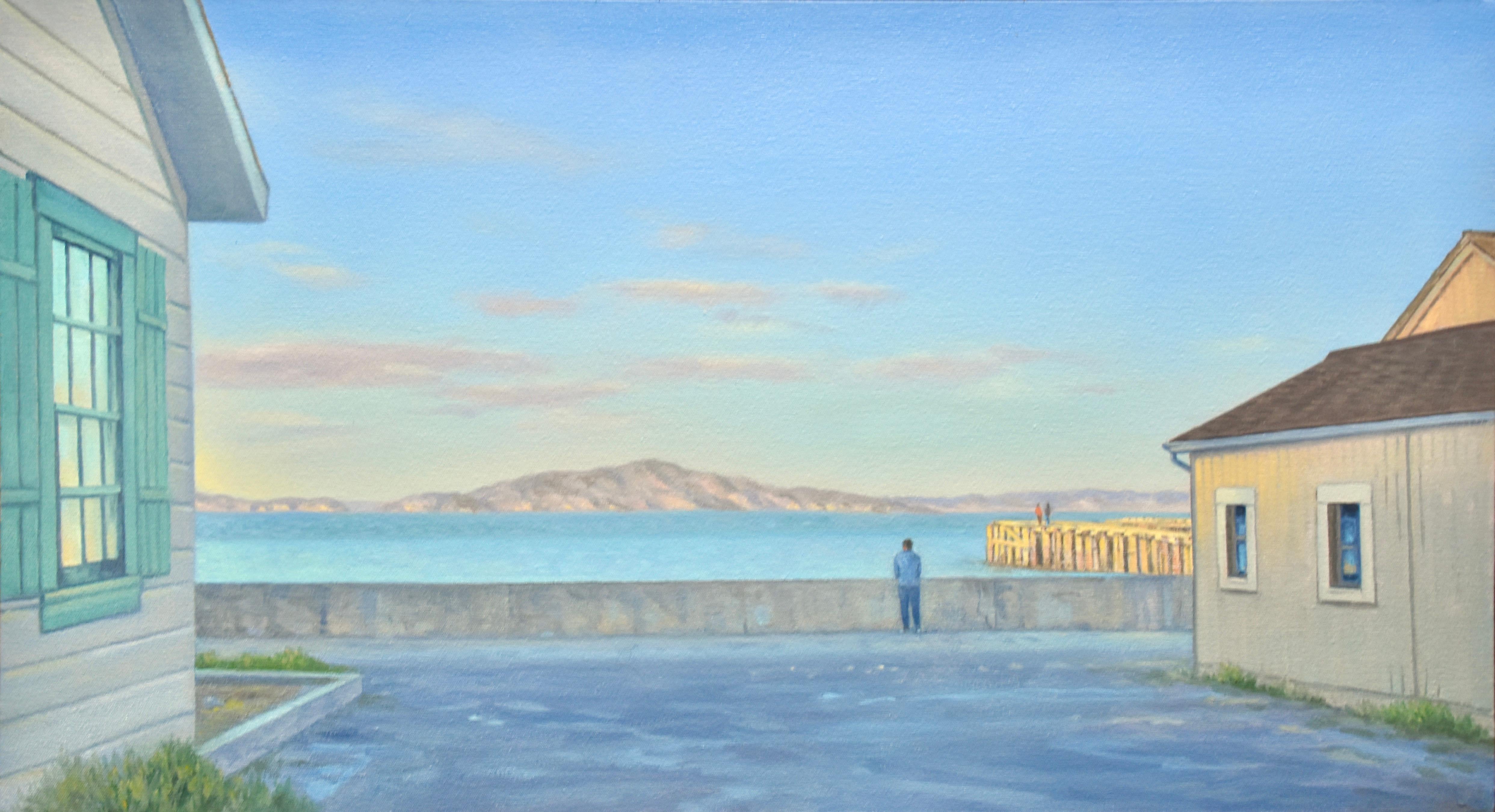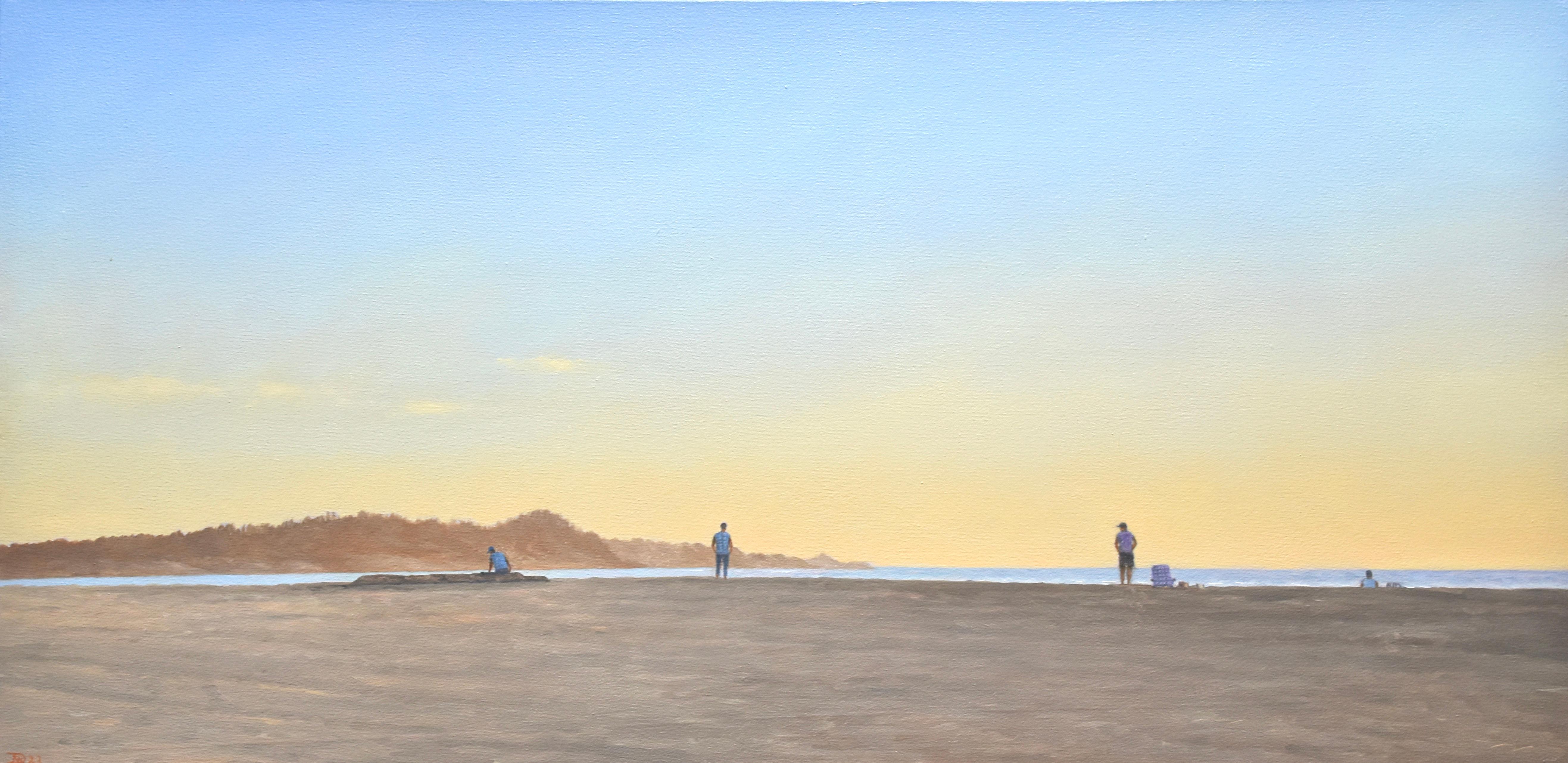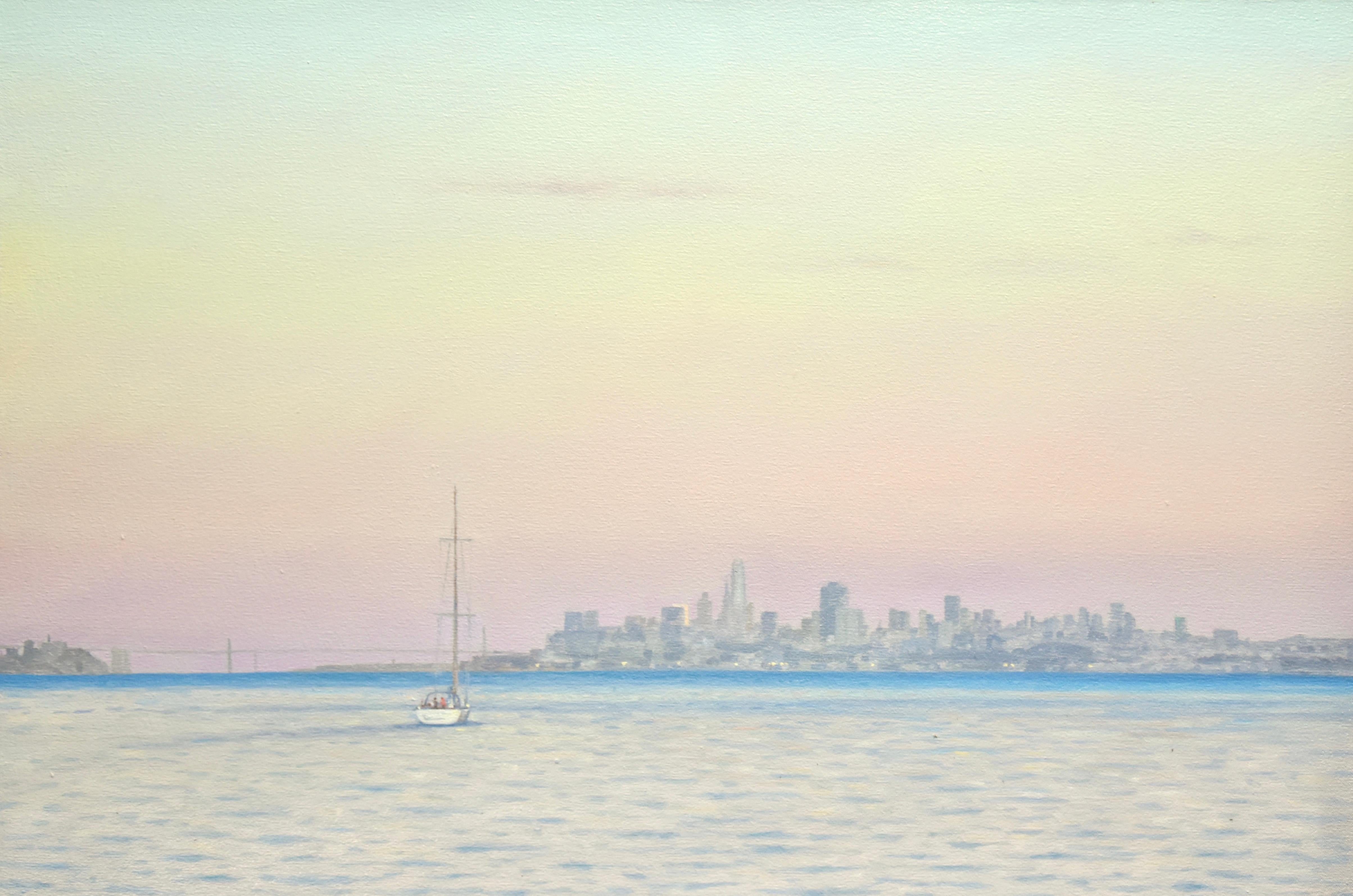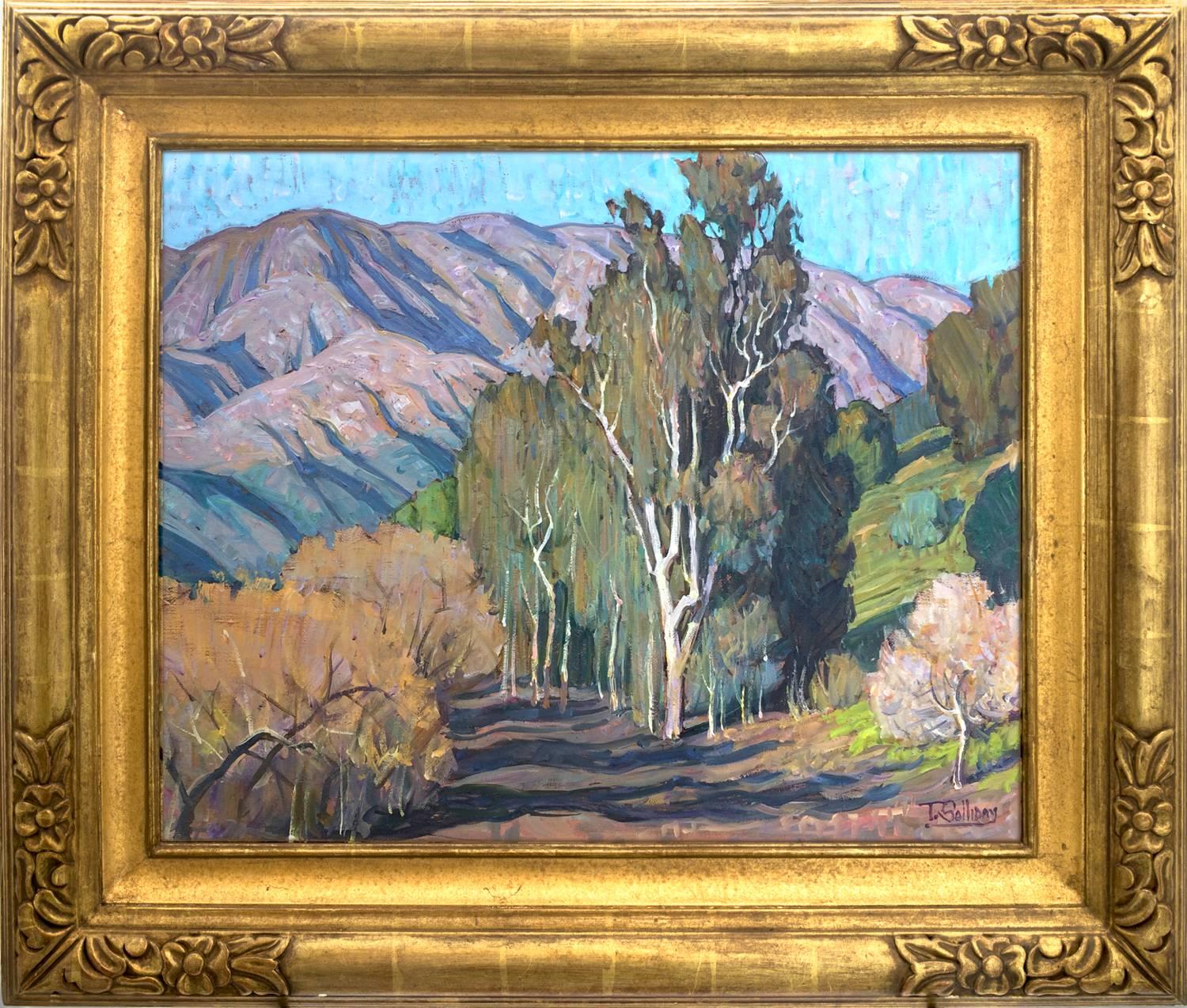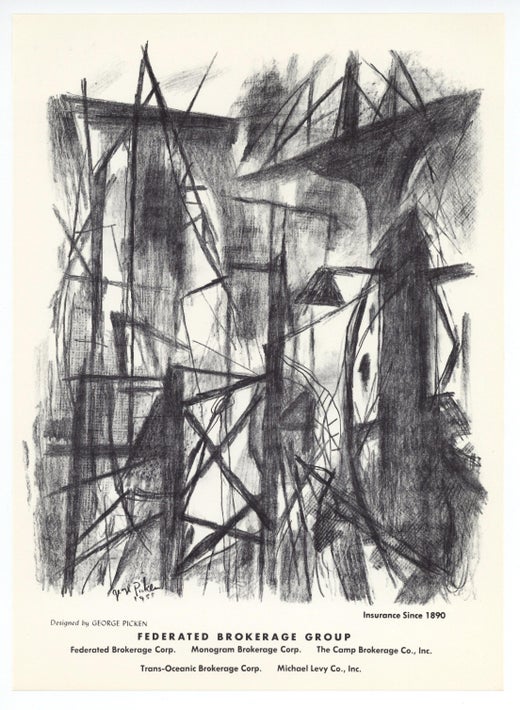Items Similar to "Blackwell's Island (Roosevelt Island, New York City), " George Picken, WPA Scene
Want more images or videos?
Request additional images or videos from the seller
1 of 8
George Picken"Blackwell's Island (Roosevelt Island, New York City), " George Picken, WPA Scene1928
1928
About the Item
George Picken (1898 - 1971)
The Octagon at Blackwell's Island (Roosevelt Island, New York City), 1928
Oil on canvas
22 x 27 inches
Signed lower right
Provenance:
D. Wigmore Fine Art, New York, circa 1999-2000
Private Collection, New York
A native New Yorker, George Picken was born in 1898. His father, an artist and photographer, emigrated from Scotland; his mother came from Wales. They joined other European immigrants settling in New York City’s Hell’s Kitchen. Picken enlisted in the army during World War I and saw action at Verdun. After the war, he stayed in France and like many Americans returning from the vibrant Paris art scene, was inspired by the radical movement known as Impressionism. Upon his return Picken decided to follow in his father’s footsteps and become an artist.
George began his studies in 1919 at the Art Students League during Robert Henri, Max Weber, and John Sloan’s tenure. There he took classes in studio art, illustration, and etching through 1923 studying extensively with George Bridgman. The writings of French philosopher Henri Bergson were widely circulated among the artistic community and looking at Picken’s early paintings one cannot help but wonder if as a young artist he was influenced by Bergson’s ideas. Bergson said, "[There are] two profoundly different ways of knowing a thing. The first implies that we move round the object; the second that we enter into it. The first depends on the point of view at which we are placed and on the symbols by which we express ourselves. The second neither depends on a point of view nor relies on any symbol. The first kind of knowledge may be said to stop at the relative; the second, in those cases where it is possible, to attain the absolute.”
Picken’s recognition came early with showings of his work while he was a student. His drawings were published in the New Masses, a significant left-wing publication. The New York Public Library honored him with one-man shows in 1924 and 1928 and his work was included in group exhibitions at the Louis Comfort Tiffany Foundation, the Whitney Studio Club, Montross Gallery, and the Art Students League. During this time Picken married Viola Carton, one of Reginald Marsh’s models, and they lived in Westchester. Later they moved to Yorkville in Manhattan between 82nd street and East End Avenue where they began their family. Picken’s grandson Niles Jaeger recalled that, “Grandpa’s home and studio were in a five-story walk-up apartment, heated only by a coal stove. But there were wonderful views of the East River and the Queensborough Bridge and he painted them repeatedly over the next three decades.”
Picken felt the financial panic and economic depression that engulfed most of the world in 1931; [he] was trying to support a wife and two children on his earnings as an artist….Franklin Delano Roosevelt promised “a new deal for the American people” at the 1932 Democratic Convention [and] the Federal Art Project was formed. During the run of the [WPA] over ten thousand artists were employed including Picken’s friends Stuart Davis and Reginald Marsh. Arshile Gorky, Isabel Bishop, Grant Wood, Ben Shahn, Adolph Gottlieb, David Smith, Willem deKooning, Jackson Pollock, Mark Rothko, Ad Reinhardt, and Paul Cadmus also found work. Along with Rockwell Kent, John Steuart Curry, and Thomas Hart Benton, Picken was commissioned to do public murals. Picken’s work can be found in the Post Offices of Hudson Falls and Fort Edward, New York and Chardon, Ohio. He also completed public murals for St. Ambrose Church in Brooklyn and Hawthorne Public School in Hawthorne, New York.
In 1933 George Picken was also offered a position as a teacher at the Art Students League. He taught printmaking there through 1942 as well as teaching painting, printmaking, and lithography at Cooper Union and holding a position at Columbia University. During this time Picken achieved notoriety for his paintings of industrial and city scenes like Mining Town. Stuart Davis remarked that his friend’s dark urban scenes were like “dungeons.” Marie Harriman, wife of railroad baron Averill Harriman, was Picken’s first patron giving him one-person shows at her gallery. In the 1940s with the guidance of Edward Hopper, Picken joined the prestigious Rehn Galleries on Madison Avenue. Rehn Galleries also exhibited the work of Reginald Marsh and Charles Burchfield. Picken’s had regular one-person shows there until his death.
George Picked retired to Tyringham and continued painting and gardening until his death at the age of seventy-three in 1971. Picken’s work is in many private and public collections including the Whitney Museum of American Art, The Corcoran Gallery of Art, The Metropolitan Museum of Art, Dartmouth College, the Kansas City Art Institute, the Smithsonian Institution, the Library of Congress, the Parrish Art Museum, Syracuse University, the Art Students League, and the Newark Museum.
- Creator:George Picken (1898 - 1971, American)
- Creation Year:1928
- Dimensions:Height: 28 in (71.12 cm)Width: 33 in (83.82 cm)
- Medium:
- Movement & Style:
- Period:
- Condition:Lined. Hairline craquelure.
- Gallery Location:New York, NY
- Reference Number:1stDibs: LU184129923522
George Picken
A native New Yorker, George Picken was born in 1898. His father, an artist and photographer, emigrated from Scotland; his mother came from Wales. They joined other European immigrants settling in New York City’s Hell’s Kitchen. Picken enlisted in the army during World War I and saw action at Verdun. After the war, he stayed in France and like many Americans returning from the vibrant Paris art scene, was inspired by the radical movement known as Impressionism. Upon his return Picken decided to follow in his father’s footsteps and become an artist. George began his studies in 1919 at the Art Students League during Robert Henri, Max Weber, and John Sloan’s tenure. There he took classes in studio art, illustration, and etching through 1923 studying extensively with George Bridgman. Picken’s recognition came early with showings of his work while he was a student. His drawings were published in the New Masses, a significant leftwing publication. The New York Public Library honored him with one-man shows in 1924 and 1928 and his work was included in group exhibitions at the Louis Comfort Tiffany Foundation, the Whitney Studio Club, Montross Gallery, and the Art Students League. Later he moved to Yorkville in Manhattan between 82nd street and East End Avenue where they began their family. Picken’s grandson Niles Jaeger recalled that, “Grandpa’s home and studio were in a five-story walk-up apartment, heated only by a coal stove. But there were wonderful views of the East River and the Queensborough Bridge and he painted them repeatedly over the next three decades.” Picken felt the financial panic and economic depression that engulfed most of the world in 1931. During the run of the [WPA] over ten thousand artists were employed including Picken’s friends Stuart Davis and Reginald Marsh. Arshile Gorky, Isabel Bishop, Grant Wood, Ben Shahn, Adolph Gottlieb, David Smith, Willem deKooning, Jackson Pollock, Mark Rothko, Ad Reinhardt, and Paul Cadmus also found work. Along with Rockwell Kent, John Steuart Curry, and Thomas Hart Benton, Picken was commissioned to do public murals. Picken’s work can be found in the Post Offices of Hudson Falls and Fort Edward, New York and Chardon, Ohio. In 1933 George Picken was also offered a position as a teacher at the Art Students League. He taught printmaking there through 1942 as well as teaching painting, printmaking, and lithography at Cooper Union and holding a position at Columbia University. During this time Picken achieved notoriety for his paintings of industrial and city scenes. Stuart Davis remarked that his friend’s dark urban scenes were like “dungeons.” Marie Harriman, wife of railroad baron Averill Harriman, was Picken’s first patron giving him one-person shows at her gallery. In the 1940s with the guidance of Edward Hopper, Picken joined the prestigious Rehn Galleries on Madison Avenue. Rehn Galleries also exhibited the work of Reginald Marsh and Charles Burchfield. Picken’s had regular one-person shows there until his death.
About the Seller
5.0
Platinum Seller
These expertly vetted sellers are 1stDibs' most experienced sellers and are rated highest by our customers.
Established in 2021
1stDibs seller since 2022
63 sales on 1stDibs
Typical response time: <1 hour
- ShippingRetrieving quote...Ships From: Larchmont, NY
- Return PolicyA return for this item may be initiated within 3 days of delivery.
More From This SellerView All
- "Tully Lumber Mill, Orange, Massachusetts, " Dorothy Eaton, WPA Factory RuralLocated in New York, NYDorothy Eaton Tully Lumber Mill, Orange, Massachusetts, 1935 Signed and dated lower right Oil on canvas 17 1/2 x 23 1/2 inches Dorothy Eaton was born in East Orange, New Jersey in 1893. She studied at Smith College...Category
1930s American Realist Landscape Paintings
MaterialsCanvas, Oil
- "Low Tide at Noon, Wellfleet, Massachusetts, " Ernest Fiene, WPA, Boat on BeachBy Ernest FieneLocated in New York, NYErnest Fiene (1894 - 1965) Low Tide at Noon, Wellfleet, Massachusetts Oil on canvas 26 x 36 inches Signed lower right Ernest Fiene was born in Elberfeld, Germany in 1894. As a teenager, Fiene immigrated to the United States in 1912. He studied art at the National Academy of Design in New York City from 1914 to 1918, taking day classes with Thomas Maynard and evening classes with Leon Kroll. Fiene continued his studies at the Beaux-Arts Institute of Design in Paris from 1916 to 1918, adding classes in printmaking at the Art Students League in 1923. Fiene began his career as an artist in 1919 with his first exhibition of watercolors at the MacDowell Club arranged by his mentor Robert Henri. In 1923 the Whitney Studio Club mounted a large exhibition of his works. The following year he had an exhibition at the New Gallery in New York, which completely sold out all fifty-two works, including paintings, watercolors, drawings, and etchings. With the proceeds of sales from the New Gallery exhibition, Ernest Fiene and his younger brother Paul, a sculptor, built studios in Woodstock, New York in 1925. In the early Twenties Ernest Fiene painted mostly landscapes of Woodstock and both the Ramapo and Hudson River Valleys. He was the subject of the first monograph for the Younger Artists Series in 1922. Published in Woodstock, the series went on to include Alexander Brook, Peggy Bacon, and Yasuo Kuniyoshi. The book reproduced 1 illustration in color and another 27 reproductions in black and white. Around 1925 Fiene became fascinated with the intensity, excitement, and opportunities for color harmonies New York City offered as a subject. His paintings shifted to urban and industrial themes with architecture, industry, and transportation becoming his subjects. By 1926 Fiene had attracted the dealer Frank K.M. Rehn, who gave him a one-man exhibition that year, which travelled to the Boston Arts Club. C.W. Kraushaar Galleries gave Fiene a one-man exhibition of urban, landscape, portrait, and still life paintings in 1927. Julianna Force, the director of the Whitney Studio Club and first director of the Whitney Museum of American Art, included two of Fiene's paintings in a fall exhibition in 1928. The Whitney Studio Club showed Fiene's paintings in a two-man exhibition with Glenn O. Coleman that year and acquired three of Fiene's paintings. Also in 1928 Fiene became affiliated with Edith Halpert's Downtown Gallery where he had an exhibition of 20 lithographs in the spring. Fiene sold his house in Woodstock in 1928 to spend more of his time in New York City. With so many successful exhibitions, Fiene returned to Paris in 1928-29 where he rented Jules Pascin's studio and studied at the Académie de la Grande Chaumière. In France, Fiene painted both landscape and urban subjects developed from ideas influenced by Cubist geometry and the use of flat areas of broad color. Upon returning to New York in 1930, Fiene used this new approach to continue to paint New York skyscraper and waterfront subjects, as well as to begin a series of paintings on changing old New York based on the excavations for Radio City Music Hall and the construction of the Empire State Building. Frank K.M. Rehn Galleries exhibited this series, titled "Changing Old New York," in 1931. Fiene also has solo exhibitions at Rehn Galleries in 1930 and 1932. Fiene's oil paintings are exhibited at the Chicago Arts Club in 1930 as well. Fiene was included in the Museum of Modern Art's exhibition Painting and Sculpture by Living Americans in December of 1931. Visiting New York, Henri Matisse saw the exhibition and called Fiene's Razing Buildings, West 49th Street the finest painting he had seen in New York. Fiene had two mural studies from his Mechanical Progress series exhibited at the Museum of Modern Art's exhibition Murals by American Painters and Photographers in 1932. Fiene sent View from my Window which depicts Fiene working on a lithograph stone while looking out his window to the newly completed Empire State Building to the Carnegie International in 1931. In 1932 Fiene participated in the first Biennial of American Painting at the Whitney Museum and his prints were included in exhibitions at the Downtown Gallery and the Wehye Gallery. In the same year, Fiene was awarded a Guggenheim fellowship to further study mural painting in Florence, Italy. On his return from Italy in 1933 Fiene re-engaged himself in New York City life and won several public and private mural projects. Fiene resumed his active exhibition schedule, participating in two group exhibitions at the Whitney Museum and a one-man exhibition of recent paintings at the Downtown Gallery in January 1934. In 1933 he purchased a farm in Southbury, Connecticut, which added Connecticut scenes to his landscape subjects. This was also the year Fiene began to spend summers on Monhegan Island, Maine, where he painted seascapes, harbor scenes, and still lifes. Fiene's landscape paintings attracted numerous commissions as part of the American Scene movement. From 1935-36 Fiene took an extended sketching trip through the urban, industrial, and farming areas of Pennsylvania and West Virginia. Most of the twenty-four Pennsylvania urban and rural paintings from this trip were featured in an exhibition held at the First National Bank in Pittsburgh in October of 1937 by the Pittsburgh Commission for Industrial Expansion. Fiene said of these works that he formed rhythm, opportunity for space and color, and integrity in the Pennsylvania mill and furnace paintings. Fiene received the silver medal for one of the Pittsburgh paintings...Category
Mid-20th Century American Realist Landscape Paintings
MaterialsCanvas, Oil
- "Along the Kanahawa River, West Virginia, " Ernest Fiene, WPA Coal SteamboatBy Ernest FieneLocated in New York, NYErnest Fiene Along the Kanahawa River, West Virginia, 1936 Signed lower right Oil on canvas 26 x 36 inches Fiene made a series of paintings, drawings and lithographs which are based on his travels through Pennsylvania and West Virginia during the winter of 1935-36. The industrial areas of Pennsylvania and West Virginia are represented in numerous oils, among which are some of his most well-known. Fiene wrote of the trip, "The increasing snow and atmospheric conditions [in the Kanawha River valley} enhanced this mountainous coal mining country with a majestic beauty." Winter on the River is Fiene's only American Artists Group print and there were only two lithographs produced from the West Virginia trip. The American Artists Group (AAG), under the direction of Carl Zigrosser, who was then working at New York's famed Weyhe Gallery, published ninety-three prints by over fifty artists in 1936 and 1937. Zigrosser's goal was to popularize contemporary American art through original prints offered at the low price of $2.75. The project was also a means to provide income for impoverished artists during the Depression. The prints were featured in many of the leading print exhibitions and publications of the period. The lithograph produced from this image is now in the collection of the Amon Carter Museum, Baltimore Museum of Art, Cleveland Museum of Art, Philadelphia Museum of Art, Pensacola Museum of Art, San Francisco Fine Arts Museum, Syracuse Museum, Yale University Art Museum. Ernest Fiene was born in Elberfeld, Germany in 1894. As a teenager, Fiene immigrated to the United States in 1912. He studied art at the National Academy of Design in New York City from 1914 to 1918, taking day classes with Thomas Maynard and evening classes with Leon Kroll. Fiene continued his studies at the Beaux-Arts Institute of Design in New York from 1916 to 1918, adding classes in printmaking at the Art Students League in 1923. Fiene began his career as an artist in 1919 with his first exhibition of watercolors at the MacDowell Club arranged by his mentor Robert Henri. In 1923 the Whitney Studio Club mounted a large exhibition of his works. The following year he had an exhibition at the New Gallery in New York, which completely sold out all fifty-two works, including paintings, watercolors, drawings, and etchings. With the proceeds of sales from the New Gallery exhibition, Ernest Fiene and his younger brother Paul, a sculptor, built studios in Woodstock, New York in 1925. In the early Twenties Ernest Fiene painted mostly landscapes of Woodstock and both the Ramapo and Hudson River Valleys. The first monograph from the Younger Artists Series was published on Fiene in 1922. Published in Woodstock, the series went on to include Alexander Brook, Peggy Bacon, and Yasuo Kuniyoshi. The book reproduced 1 illustration in color and another 27 reproductions in black and white. Around 1925 Fiene became fascinated with the intensity, excitement, and opportunities for color harmonies New York City offered as a subject. His paintings shifted to urban and industrial themes with architecture, industry, and transportation becoming his subjects. By 1926 Fiene had attracted the dealer Frank K.M. Rehn, who gave him a one-man exhibition that year, which travelled to the Boston Arts Club. C.W. Kraushaar Galleries gave Fiene a one-man exhibition of urban, landscape, portrait, and still life paintings in 1927. Julianna Force, the director of the Whitney Studio Club and first director of the Whitney Museum of American Art, included two of Fiene’s paintings in a fall exhibition in 1928. The Whitney Studio Club showed Fiene’s paintings in a two-man exhibition with Glenn O. Coleman that year and acquired three of Fiene’s paintings. Also in 1928 Fiene became affiliated with Edith Halpert’s Downtown Gallery where he had an exhibition of 20 lithographs in the spring. Fiene sold his house in Woodstock in 1928 to spend more of his time in New York City. With so many successful exhibitions, Fiene returned to Paris in 1928-29 where he rented Jules Pascin's studio and studied at the Académie de la Grande Chaumière. In France, Fiene painted both landscape and urban subjects developed from ideas influenced by Cubist geometry and the use of flat areas of broad color. Upon returning to New York in 1930, Fiene used this new approach to continue to paint New York skyscraper and waterfront subjects, as well as to begin a series of paintings on changing old New York based on the excavations for Radio City Music Hall and the construction of the Empire State Building. Frank K.M. Rehn Galleries exhibited this series, titled “Changing Old New York,” in 1931. Fiene also has solo exhibitions at Rehn Galleries in 1930 and 1932. Fiene’s oil paintings are exhibited at the Chicago Arts Club in 1930 as well. Fiene was included in the Museum of Modern Art’s exhibition Painting and Sculpture by Living Americans in December of 1931. Visiting New York, Henri Matisse saw the exhibition and called Fiene’s Razing Buildings, West 49th Street the finest painting he had seen in New York. Fiene had two mural studies from his Mechanical Progress series exhibited at the Museum of Modern Art’s exhibition Murals by American Painters and Photographers in 1932. Fiene sent View from my Window which depicts Fiene working on a lithograph stone while looking out his window to the newly completed Empire State Building to the Carnegie International in 1931. In 1932 Fiene participated in the first Biennial of American Painting at the Whitney Museum and his prints were included in exhibitions at the Downtown Gallery and the Wehye Gallery. In the same year, Fiene was awarded a Guggenheim fellowship to further study mural painting in Florence, Italy. On his return from Italy in 1933 Fiene re-engaged himself in New York City life and won several public and private mural projects. Fiene resumed his active exhibition schedule, participating in two group exhibitions at the Whitney Museum and a one-man exhibition of recent paintings at the Downtown Gallery in January 1934. In 1933 he purchased a farm in Southbury, Connecticut, which added Connecticut scenes to his landscape subjects. This was also the year Fiene began to spend summers on Monhegan Island, Maine, where he painted seascapes, harbor scenes, and still lifes. Fiene’s landscape paintings attracted numerous commissions as part of the American Scene movement. Through the fall and winter of 1935-36, Fiene took an extended sketching trip through the urban, industrial, and farming areas of Pennsylvania and West Virginia. Most of the twenty-four Pennsylvania urban and rural paintings from this trip were featured in an exhibition held at the First National Bank in Pittsburgh in October of 1937 by the Pittsburgh Commission for Industrial Expansion. Fiene said of these works that he formed rhythm, opportunity for space and color, and integrity in the Pennsylvania mill and furnace paintings. Fiene received the silver medal for one of the Pittsburgh paintings...Category
1930s American Realist Landscape Paintings
MaterialsCanvas, Oil
- "Factory on the River, " Modernist and Precisionist WPA Industrial New York SceneBy William SharpLocated in New York, NYWilliam Sharp (1900 - 1961) Factory on the River Oil on canvas 17 1/2 x 23 1/4 inches Initialed lower right: WS Provenance: Estate of the artist Private Collection, New York Swann Auction Galleries, American Art, June 13, 2019, Lot 178 William Sharp was born on June 13, 1900, in Lemberg, Austria, where he attended college and the Academy for Arts and Industry. He later studied in Kraków, Poland, and in Berlin and Munich, Germany. Sharp began his career as a designer of stained-glass windows and as a painter of murals. He served in the German army during World War I. After the war he became a newspaper artist in Berlin and a well-known etcher. Sharp drew political cartoons that were bitterly critical of the growing Nazi movement. As the influence of National Socialism intensified, he began to contribute drawings, under a pseudonym, to publications that were hostile to Hitler. After Hitler assumed power, Sharp was confronted with these drawings and told that he would be sent to a concentration camp. However, in 1934, he escaped to the United States. His first newspaper assignment in America was making courtroom sketches for The New York Mirror...Category
Mid-20th Century American Realist Landscape Paintings
MaterialsCanvas, Paint, Oil
- "Colonial Sand and Stone Company, New York, " Industrial WPA Scene, PrecisionistBy William SharpLocated in New York, NYWilliam Sharp (1900 - 1961) Factory on the River Oil on canvas 20 1/2 x 28 1/2 inches Initialed lower left: WS Provenance: Estate of the artist Private Collection, New York Swann Auction Galleries, American Art, June 13, 2019, Lot 178 Private Collection, New York Colonial Sand and Stone Co., founded by Generoso Pope, was once the country’s largest sand and gravel business, providing the concrete for much of New York City’s skyline, including the Empire State Building, Rockefeller Center, Radio City Music Hall, airports and subways. William Sharp was born on June 13, 1900, in Lemberg, Austria, where he attended college and the Academy for Arts and Industry. He later studied in Kraków, Poland, and in Berlin and Munich, Germany. Sharp began his career as a designer of stained-glass windows and as a painter of murals. He served in the German army during World War I. After the war he became a newspaper artist in Berlin and a well-known etcher. Sharp drew political cartoons that were bitterly critical of the growing Nazi movement. As the influence of National Socialism intensified, he began to contribute drawings, under a pseudonym, to publications that were hostile to Hitler. After Hitler assumed power, Sharp was confronted with these drawings and told that he would be sent to a concentration camp. However, in 1934, he escaped to the United States. His first newspaper assignment in America was making courtroom sketches for The New York Mirror...Category
Mid-20th Century American Realist Landscape Paintings
MaterialsCanvas, Paint, Oil
- "Lunch Break” Fletcher Martin, Men Working, Bricklayers, WPA, American SceneBy Fletcher MartinLocated in New York, NYFletcher Martin Lunch Break, circa 1940 Signed lower right Oil on canvas 31 1/2 x 37 3/8 inches When Fletcher Martin died in 1979, the New York Times entitled his obituary “Artist o...Category
1940s American Realist Landscape Paintings
MaterialsOil, Canvas
You May Also Like
- Angel Island, 2023By Willard DixonLocated in Burlingame, CAOil painting by Willard Dixon featuring a figure enjoying the view of Angel Island from San Francisco. Willard Dixon, who is one of the finest American contemporary realist painters today, has painted coastal landscapes for 35 years, capturing the undeniable beauty of the West with its grand and humble spirit. The painting, with its atmospheric light and calm palette is contemporary and serene. Dixon’s work can be found in numerous distinctive private and public collections, as well as the San Francisco Museum of Art, and the Metropolitan Museum of Art and his work is collected Internationally. Artist signed and dated. A classic Dixon that will sure to bring those who view it a life time of pleasure. Angel Island, painted in 2023. the canvas is 30 X 30 inches. Oil on canvas, and traditionally framed in contemporary, minimal hardwood floater frame.Condition is new and excellent. Artist signed and dated. Ready to ship. Proudly presented by Andra Norris Gallery in California. Selected Collections The San Francisco Museum of Modern Art The Metropolitan Museum of Art The Oakland Museum The Utah Museum of Fine Art San Francisco Art Commission Shaklee Corporation Pacific Gas and Electric Company, San Francisco, CA Kemper Insurance Company, Long Grove, Il Morrison and Foerester, San Francisco, CA SSI Container Corporation, San Francisco, CA San Francisco International Airport Oxford Petroleum Company, Houston,TX California First Bank, San Francisco, CA United Pipeline, Houston, TX Security Pacific National Bank, S.F., CA Crocker Bank, Los Angeles, CA Visa Corporation, San Francisco, CA Atlantic Richfield Corporation Shell Oil, Houston, TX First National Bank of Seattle RREEF Corporation, San Francisco, CA Texas Heritage Society Genstar Corporation, San Francisco, CA Sohio Corporation Skidmore Owings and Merrill, N.Y.C., NY Chemical Bank...Category
21st Century and Contemporary American Realist Landscape Paintings
MaterialsCanvas, Oil
- Angel Island, Evening, 2023By Willard DixonLocated in Burlingame, CAOil painting by Willard Dixon featuring a figure enjoying the view of Angel Island from San Francisco's Crissy Field. Willard Dixon, who is one of the finest American contemporary re...Category
21st Century and Contemporary American Realist Landscape Paintings
MaterialsCanvas, Oil
- Evening Beach, 2023By Willard DixonLocated in Burlingame, CAOil painting by Willard Dixon featuring figures enjoying an evening at a beach. Willard Dixon, who is one of the finest American contemporary realist painters today, has painted coas...Category
21st Century and Contemporary American Realist Landscape Paintings
MaterialsCanvas, Oil
- 2023By Willard DixonLocated in Burlingame, CAWillard Dixon, 'San Francisco, Dusk' was painted in 2023. The original painting is 25 X 37 inches. Framed in a contemporary minimal hardwood, 25.5 x 37.5 inches. Ready to hang and en...Category
21st Century and Contemporary American Realist Landscape Paintings
MaterialsCanvas, Oil
- Marin Islands, DuskBy Willard DixonLocated in Burlingame, CAWillard Dixon, 'Marin Islands' was painted in 2023. The original painting is 19 X 52 inches. Framed in a contemporary minimal hardwood, 19.5 x 52.5 inches. Ready to hang and enjoy ov...Category
21st Century and Contemporary American Realist Landscape Paintings
MaterialsCanvas, Oil
- Pathway to the San Gabrielino Trail; Neglected and ProtectedBy Tim SollidayLocated in Pasadena, CAProvenance Acquired by the gallery directly from the artist Painted en plein air in the San Gabriel Mountains near the artist's home in the early summer of 2013. Description As part...Category
2010s American Realist Landscape Paintings
MaterialsCanvas, Oil
Recently Viewed
View AllMore Ways To Browse
French Island
European Island
Antique Islands
Wood Island
George Marks
1940s Island
Etching New York City
New York Apartment
Round Island
Antique Wood Island
Native American Warror
Native American War Art
Used Island For Kitchen
French Industrial Island
Louis Comfort Tiffany Art Work
Island Etching
Kitchen Work Island
Louis Comfort Tiffany Paintings

